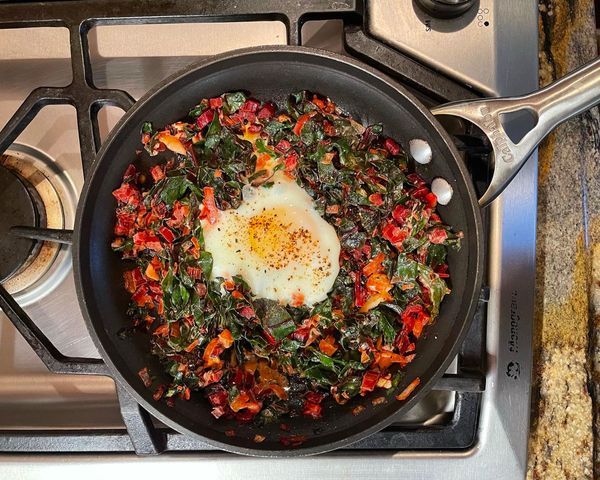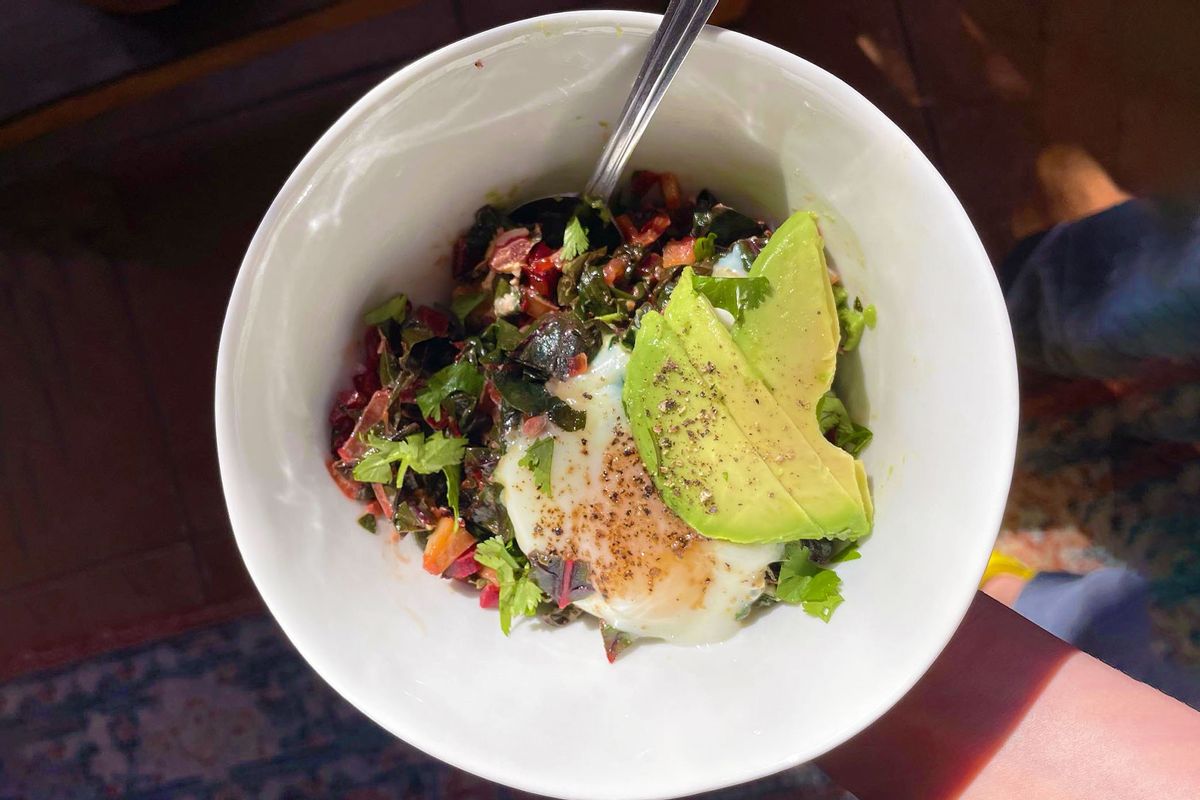I'm not sure how central a role eggs play in your life. For me, they're utterly essential. I'm not just talking about how eggs for dinner are a lifesaver in a pinch, or the fact that an egg topper on salads and grain bowls magics them into meals, or that egg yolks make as fine a dressing base as they do pasta sauce. I mean that egg cookery is so central to my weekly sustenance that I will actually tailor it to different emotional states. Let me explain.
A sunny side-up egg — made by cracking eggs into an oiled pan, covering and letting them cook till just set — can lay the framework for a generally optimistic day. This holds true both because the eggs look cheerful on the plate and the act of dabbing toast corners into the yolks is a delightful, satisfying activity. Therefore, I prefer to serve them with buttered toast points on gloomy mornings when nothing seems to be going right. If I accidentally puncture the yolk while cracking them or otherwise screw them up, I can thunder around and complain bitterly about the unfairness of it all. (So in effect, nothing about my s**tty day has changed.) On the other hand, if I get them just right, things tend to look up after breakfast.
Omelets can suit a range of mental states depending on preparation style. The French version — an oozy middle encased in a smooth, pale-yellow exterior, demands concentration, self-assuredness and a deft hand as I shake the egg in a foaming pat of butter until set on the bottom then somersault it onto the plate. But if I arrive in the kitchen as a harried, distracted creature — phone in one hand and head full of to-do list items — I just pour those beaten eggs into the pan. Maybe I roll the pan around and run a spatula around the edges to give the uncooked parts some contact; maybe I throw in a little diced ham or scallions or grated cheese. Or maybe I get sidetracked by an Instagram Reel of a guy reviewing Domino's Loaded Tots and forget all about the omelet. The bottom may brown much more than I like while the top remains runny. Regardless, it's a filling lunch I made myself despite barely existing in the present moment.
The hard-scrambled egg almost too obviously signifies the sort one would make in a fit of impatient rage. (We get it; you took out your frustration on the eggs.) But the method also has a brash, busy confidence that I like to emulate.
"I'm far too important to spare more than a few minutes preparing lunch!" I say, as I press and scramble beaten eggs in plenty of grapeseed oil. "Someone else will have to clean the egg residue off this pan!"
I reserve the custardy soft-scrambled egg, silky and palest yellow, for times I feel effortlessly elegant, like Nigella Lawson stirring a cauldron of risotto with all the time in the world (and only the most complimentary lighting).
"Break out the caviar garnish!" I cry, as the tiny, glossy curds finally emerge after I've prodded them gently towards cooked over low heat for what feels like hours. "I'll be in the other room, changing into a breezy, timelessly stylish ensemble."
I think I mainly avoid poaching out of insecurity.
A lacy-edged fried egg is just the sort I like to set atop an expertly charred stir fry, because the whole dish makes me feel like a master of short-order cookery — and, in that moment — of my broader domain. The egg, slid into a smoking-hot oiled skillet then basted with said fat until done, is just an added flex, as in: "Behold my mastery of the sear."
Indeed, I've found that the level of expertise I bring to each egg-cooking method directly correlates to my mood when deploying them. Egg poaching, for instance, is a serious business. Although I'm generally in an ambitious, cheffy state to begin, uncertainty inevitably creeps in once I start the whirlpool in the simmering water tinged with vinegar and carefully lower in the cracked egg. I like to tell myself this is because I much prefer the texture of the whites in a soft-boiled egg, but I think I mainly avoid poaching out of insecurity.
On that note, I can practically boil eggs in my sleep, thanks to chef J Kenji Lopez Alt's technique: Bring water to a simmer in a medium pot (I like adding a pinch of salt to help solidify the whites if an egg cracks). Gently lower the eggs into the water with a slotted spoon or strainer. Cook for exactly 6 minutes, then remove the eggs with a slotted spoon, peel and serve. I like making these when I'm sad, because peeling then cutting them in half to reveal that glistening yolk the color of goldenrod is like opening a food present.
 Eggs with Creamed Collards (Maggie Hennessy)
Eggs with Creamed Collards (Maggie Hennessy)
Of course, life often presents a messier stew of situations and emotions than the aforementioned examples. Take the below recipe, in which a single egg bore the heavy burden of coaxing me out of a deep malaise. I woke up feeling blue, with a sprinkling of self-doubt — meaning lunch called for comfort without too much effort, plus a dash of smugness. A one-pan situation with crusty bread for sopping provided a natural starting point.
Want more great food writing and recipes? Subscribe to Salon Food's newsletter, The Bite.
I sautéed my wilting collard greens ("stems and all!" I bragged to no one) with aromatics, lemon and a little cream. Then I made a hole in that nest of greens big enough to crack a single egg inside. I covered the pan, allowing the steam rising from the vegetables to gently set the top side of the white. I coaxed my little edible work of art into my prettiest serving bowl and gazed at it for a moment before plunging the bread into the oozing, sunny yolk. Why was I blue again today?
Ingredients
½ bunch collard greens
Olive oil, as needed
1 shallot or ½ small red onion, diced
Salt
Freshly ground black pepper
3 garlic cloves, chopped
2 tsp chopped cilantro, divided
Juice of 1 lemon, divided
2-3 Tbsp heavy cream
1 large egg
½ an avocado, sliced and seasoned with salt and pepper, for serving
Crusty bread, for serving
Directions
-
Remove the leaves from the collard green stems; small dice the stems. Then roll up the leaves and slice them into ½-inch thick ribbons. Set the leaves aside.
-
In a small or medium nonstick skillet, heat a few teaspoons of olive oil over medium-high heat until the oil slides easily around the pan. Add the shallot or onion, diced collard stems, a good pinch of salt and a few grinds of black pepper. Cook, stirring frequently, until the vegetables start to soften and caramelize at the edges, about 5 minutes. Add the garlic and half the cilantro, and sauté for another minute, until the garlic becomes fragrant. Add the collard leaves in batches until they start to wilt, along with another sprinkling of salt and pepper to taste. Squeeze in the juice of half the lemon, and add the heavy cream and a tiny splash of water from your drinking glass, stirring to combine. Cook for 1 minute more.
-
Make a small hole in the center of the greens and drizzle in a bit more olive oil if the pan looks dry. Crack the egg into the hole, and season with a small pinch of salt and pepper. Cover the skillet, and cook until the egg white is set and the yolk is done to your liking, 7 to 10 minutes.
-
To serve, make a bed with the collards in a shallow bowl, and carefully slide the egg on top. Arrange the avocado slices on top, squeeze the remaining lemon juice over everything and sprinkle with cilantro. Serve immediately with a hunk of your favorite crusty bread, buttered if you please.
Read more
from this author
Salon Food writes about stuff we think you'll like. While our editorial team independently selected these products, Salon has affiliate partnerships, so making a purchase through our links may earn us a commission.



Shares